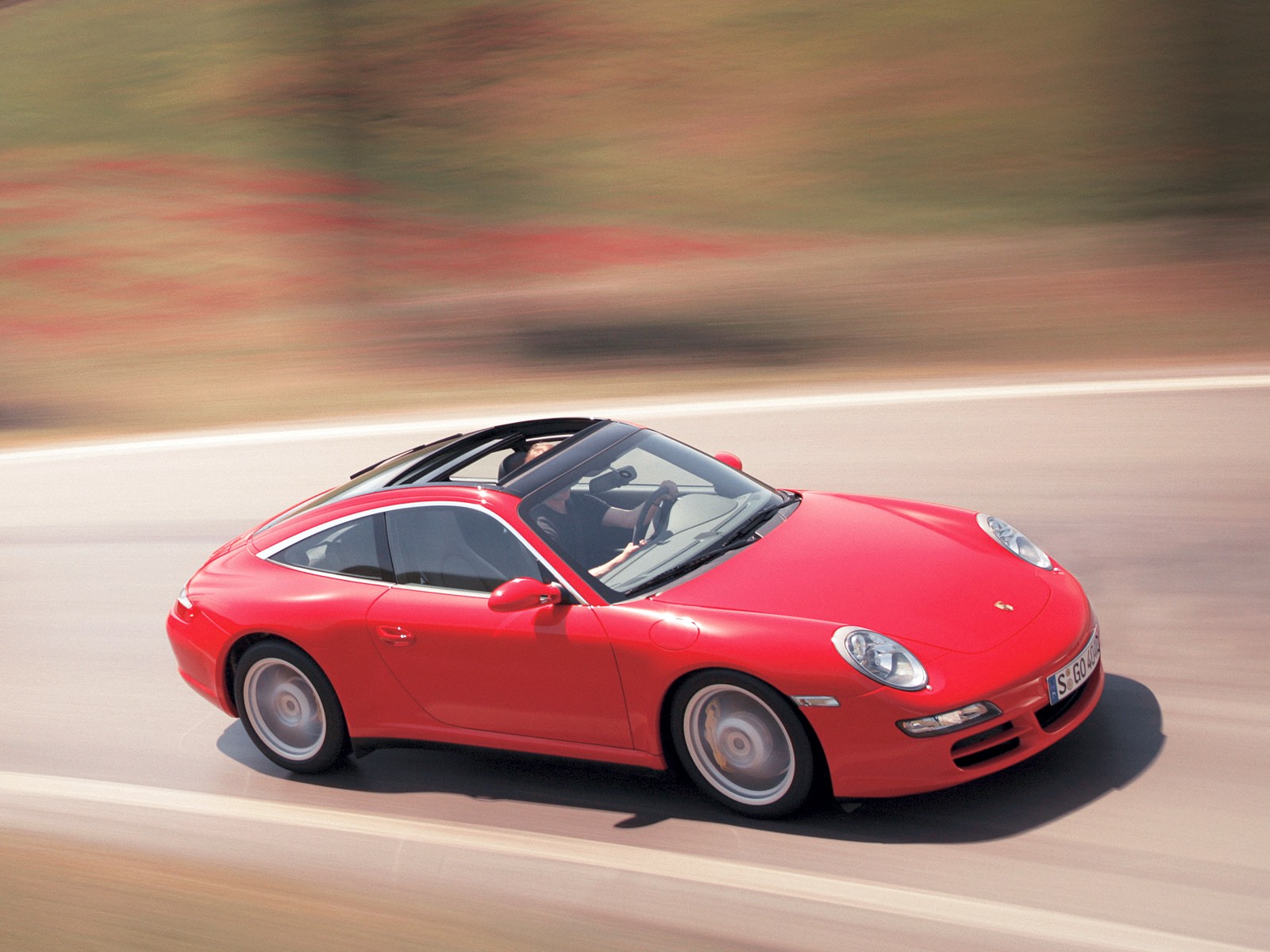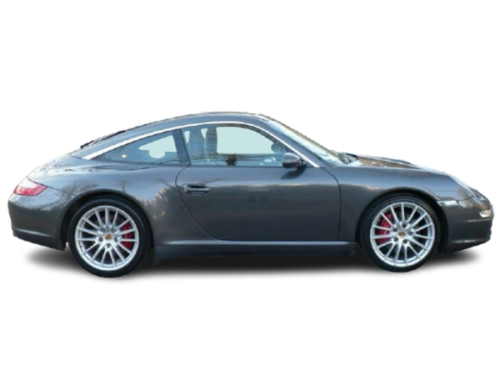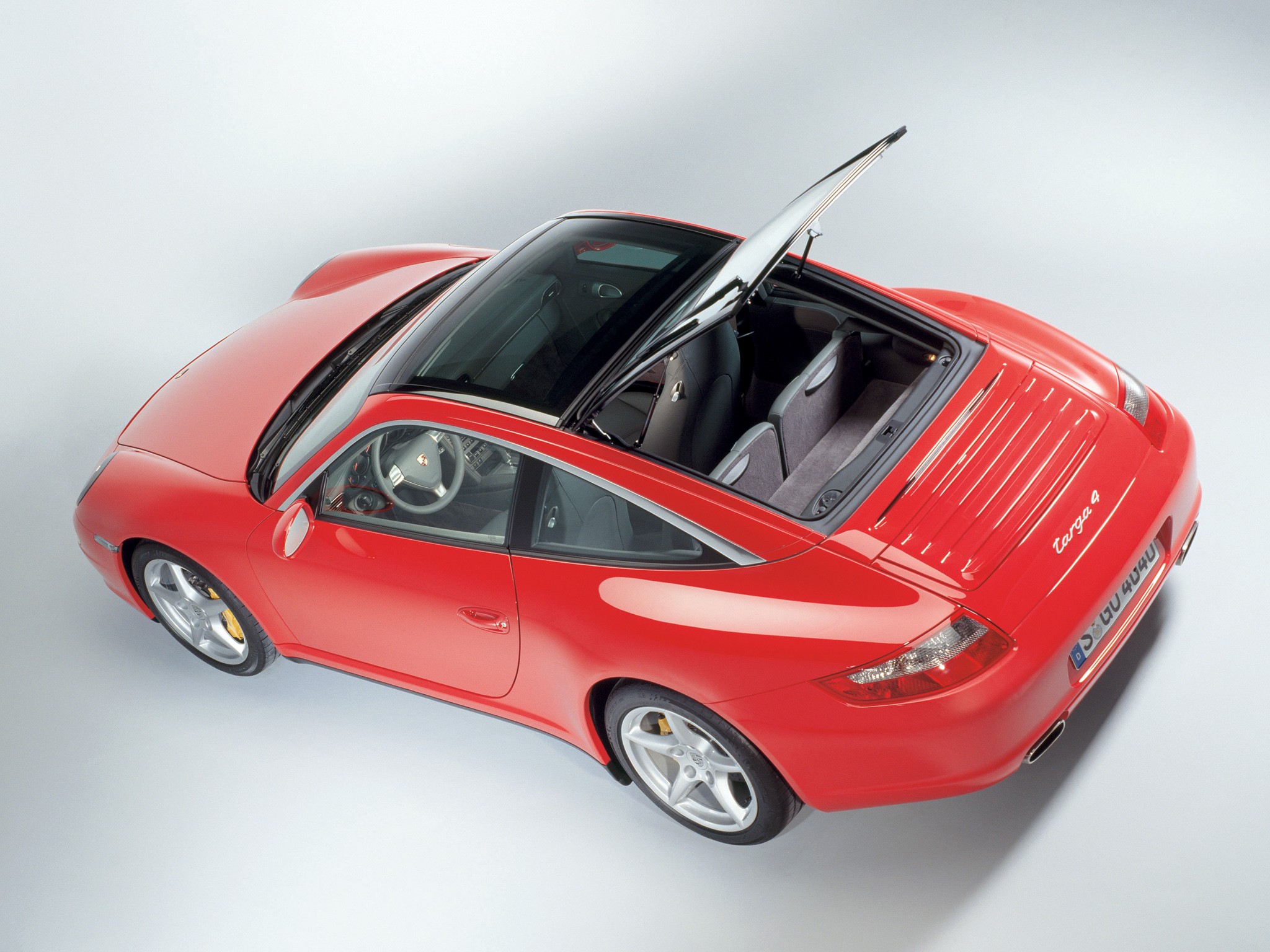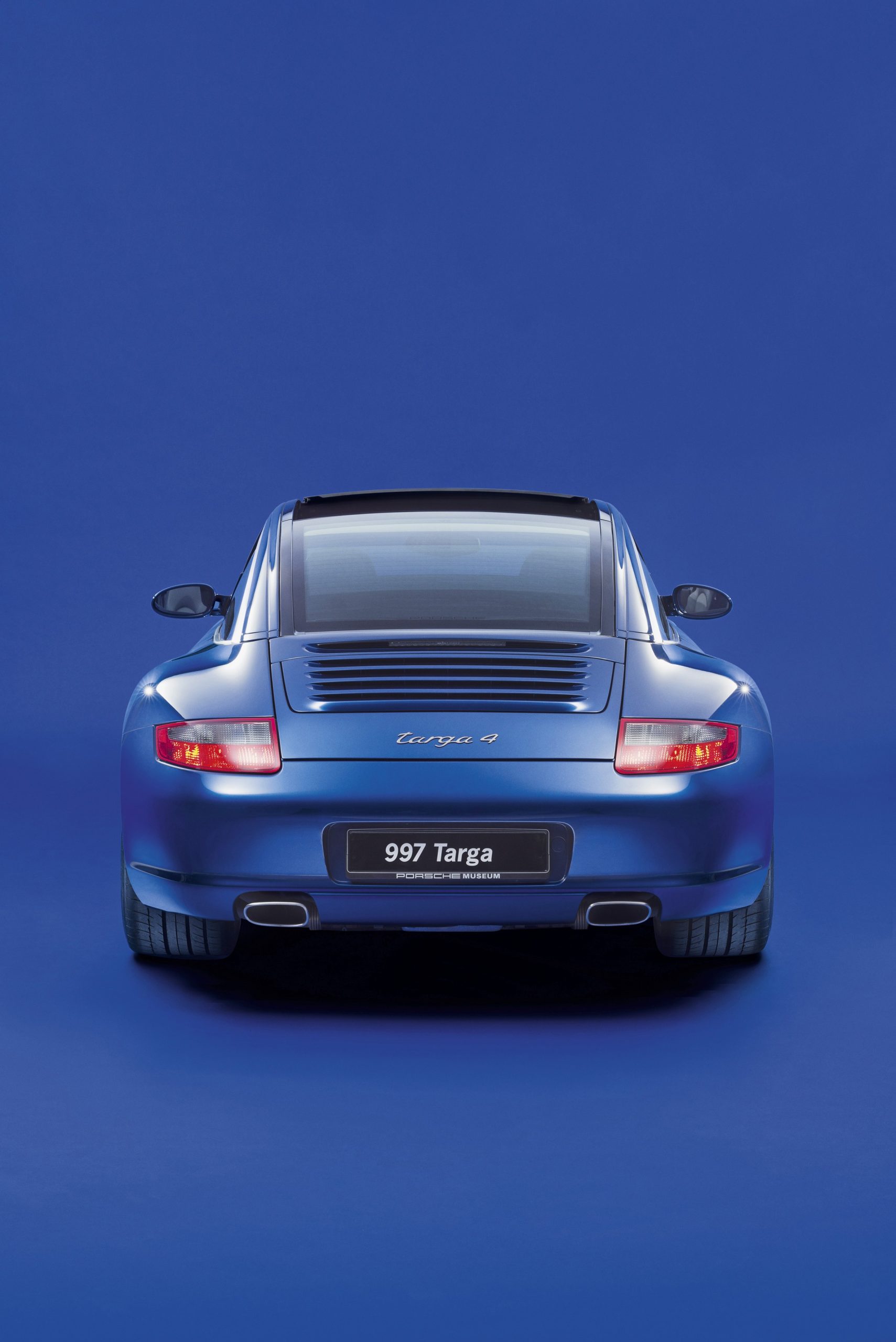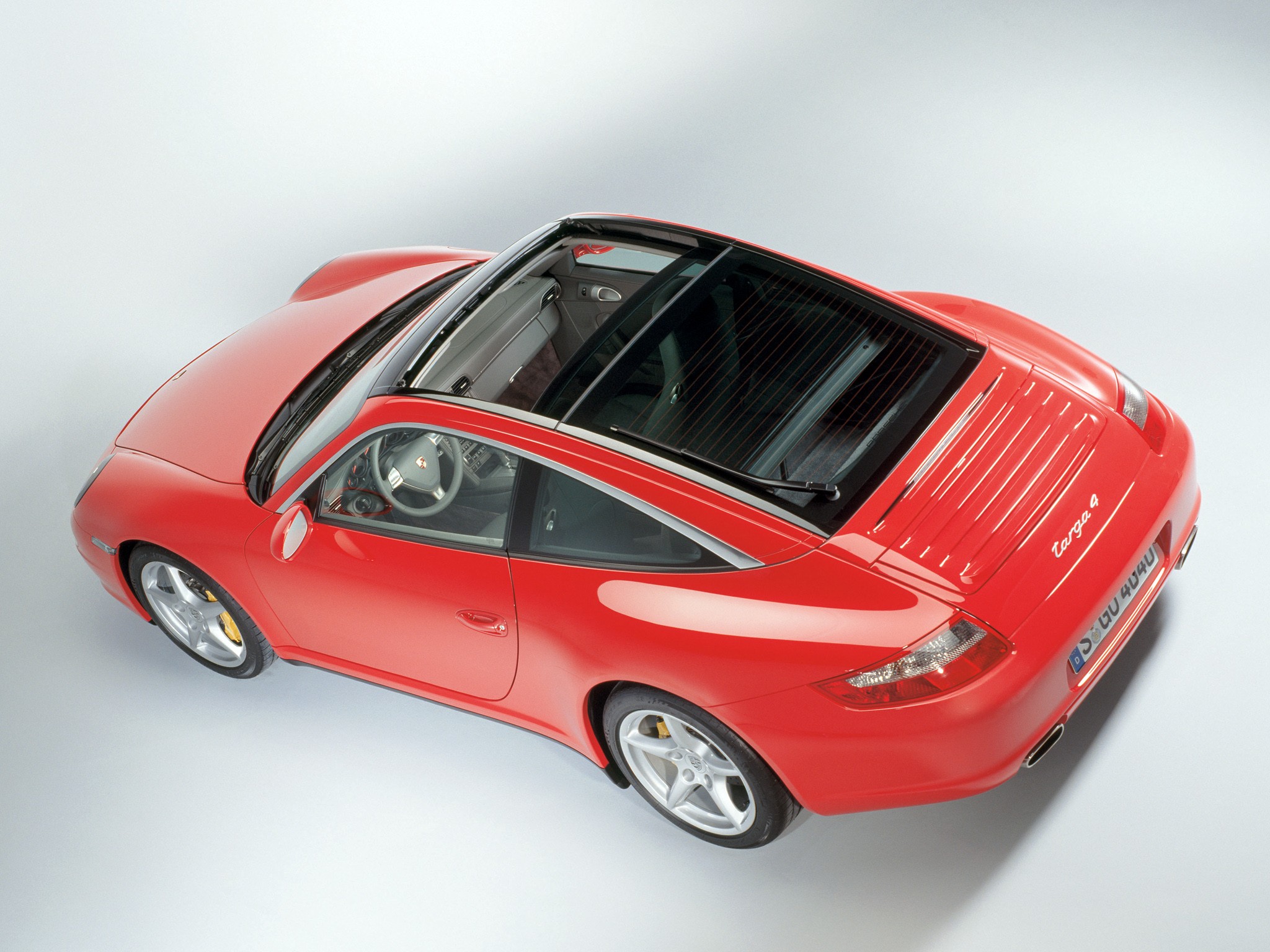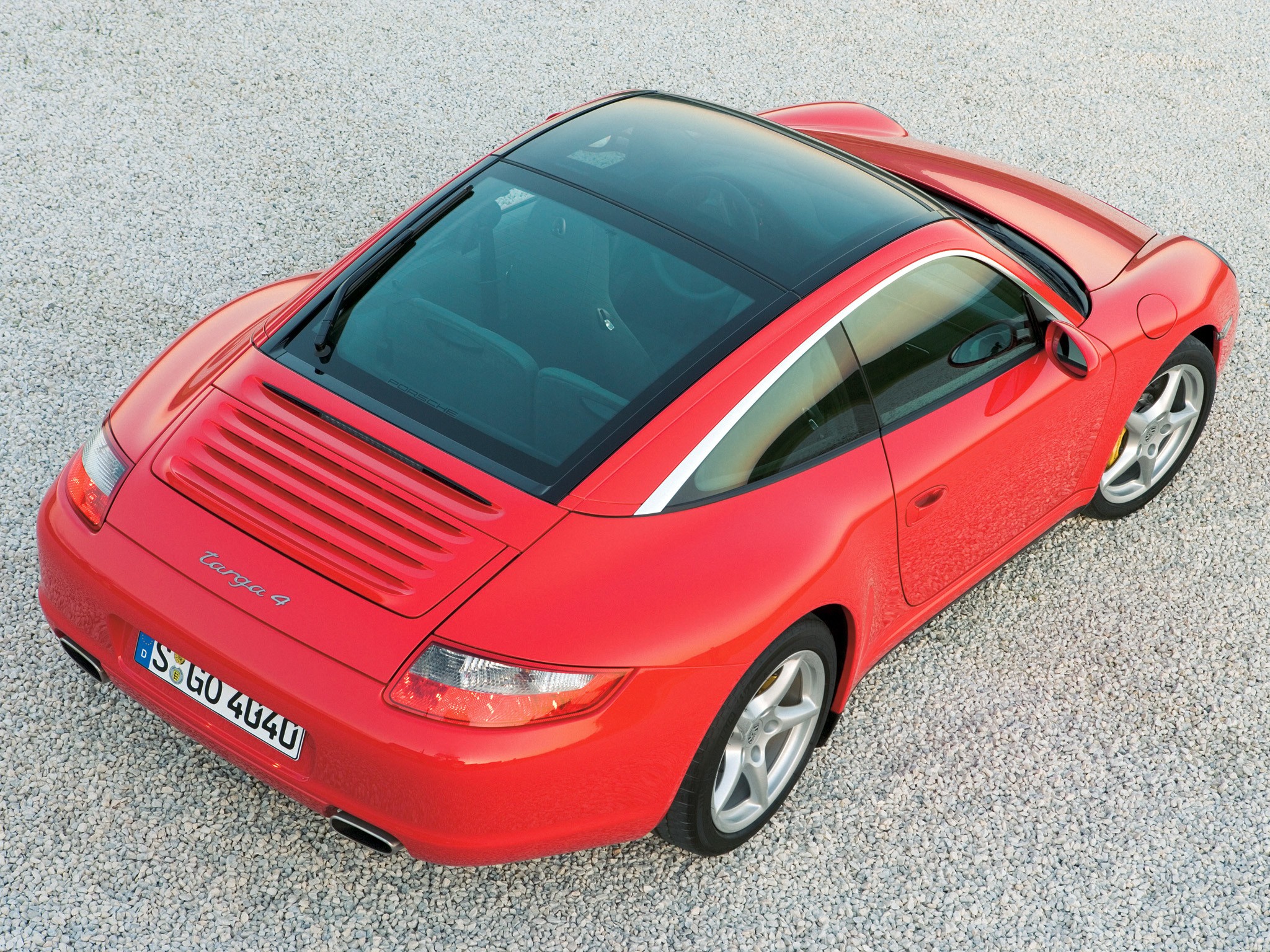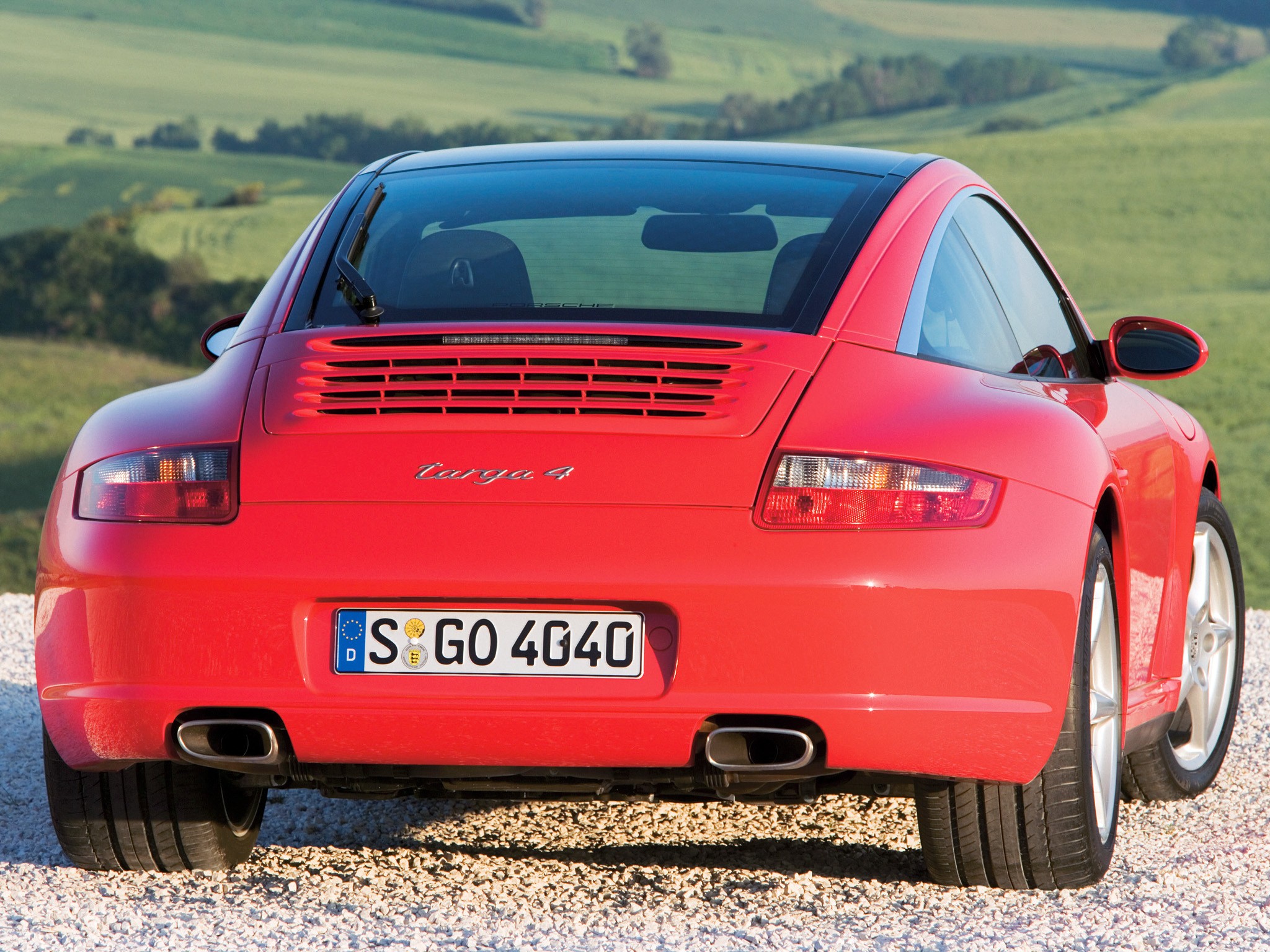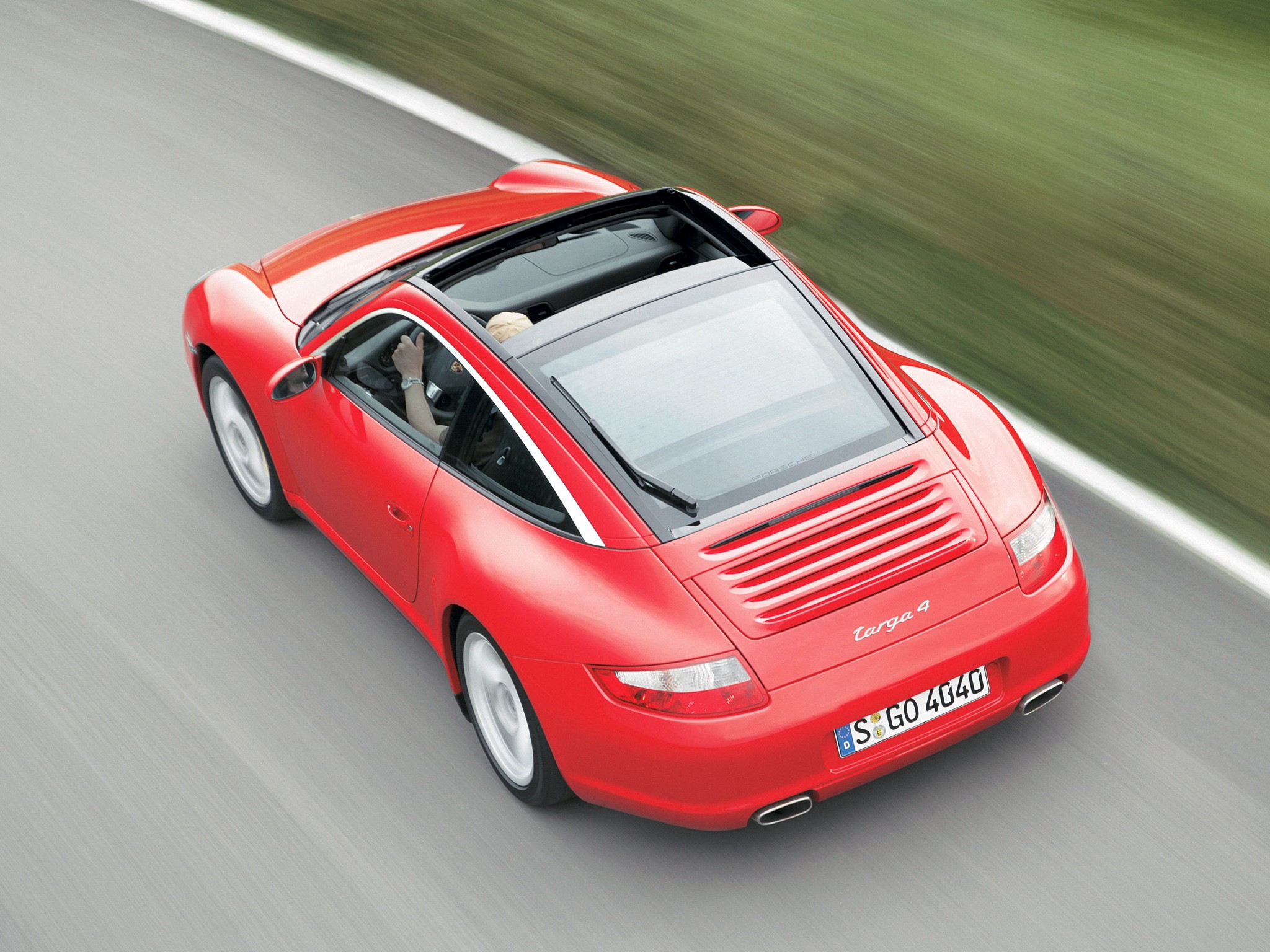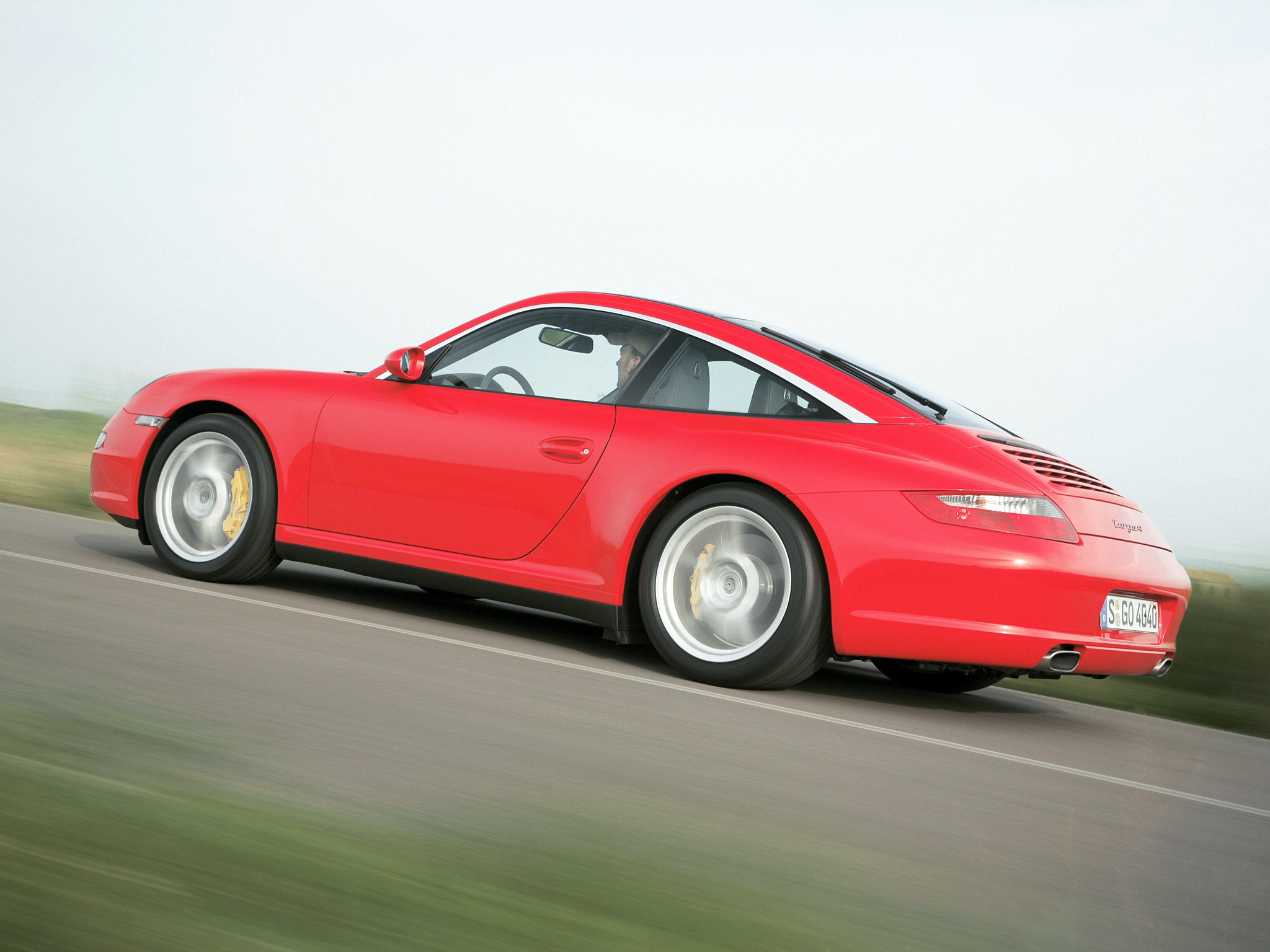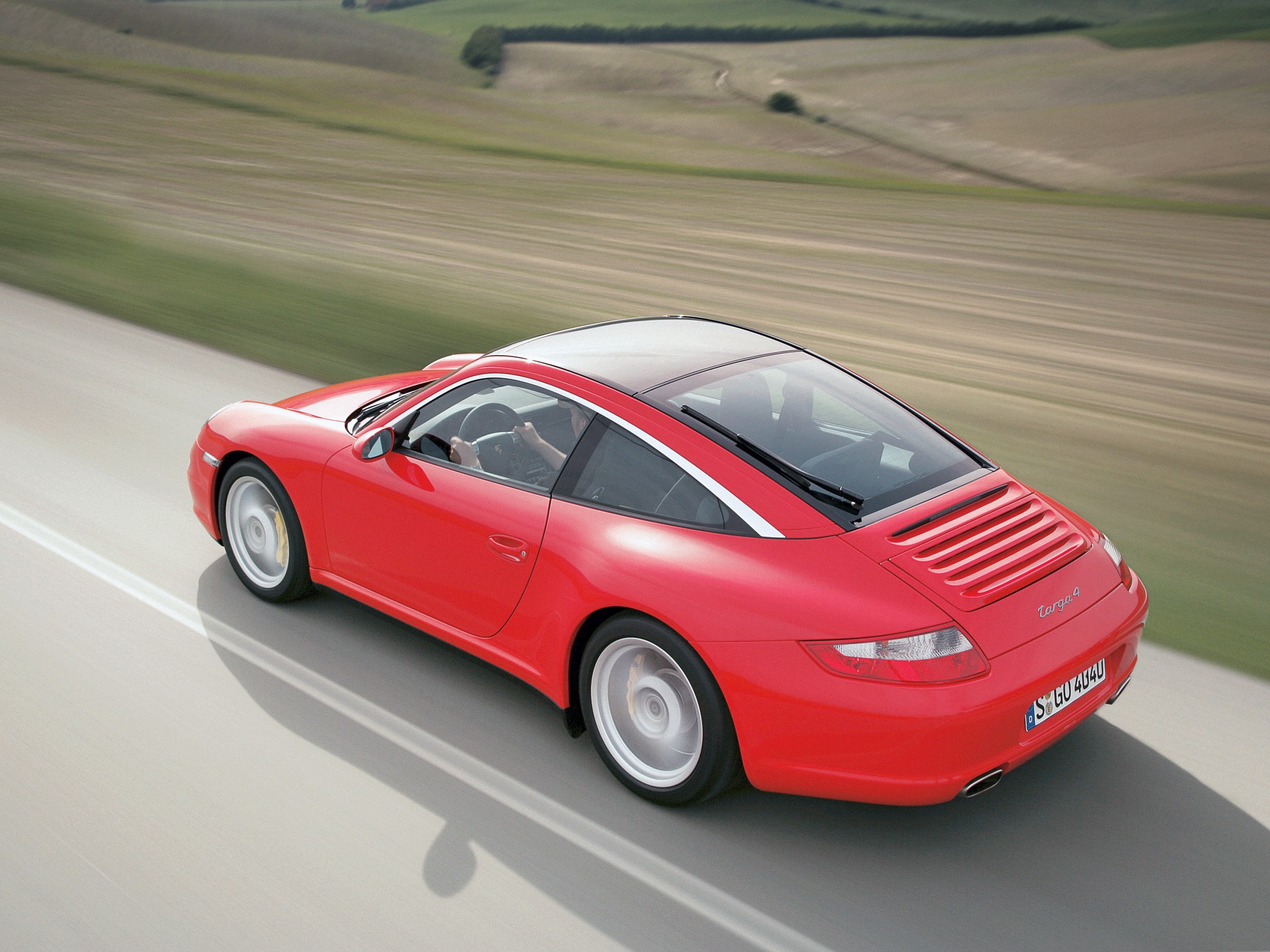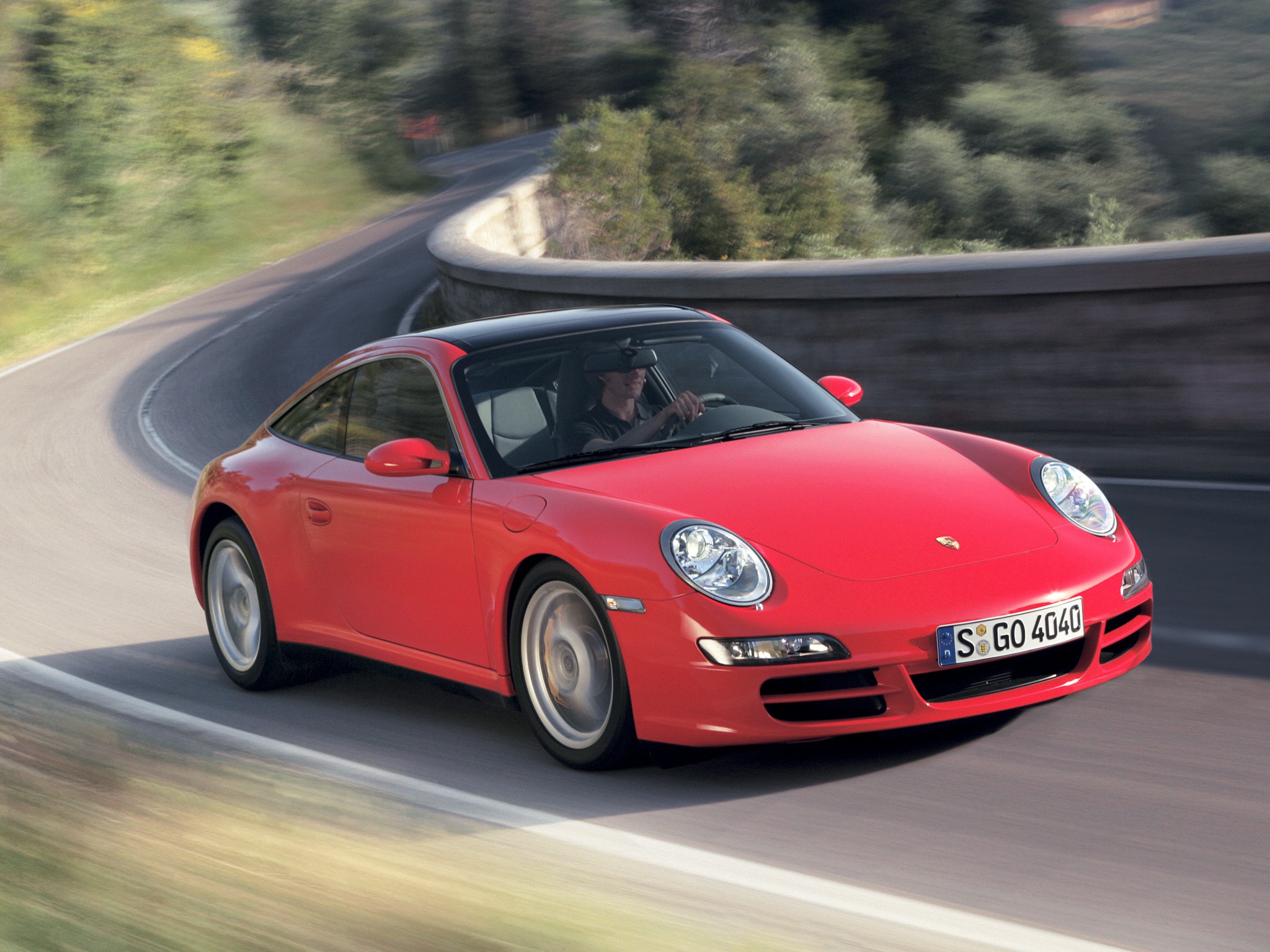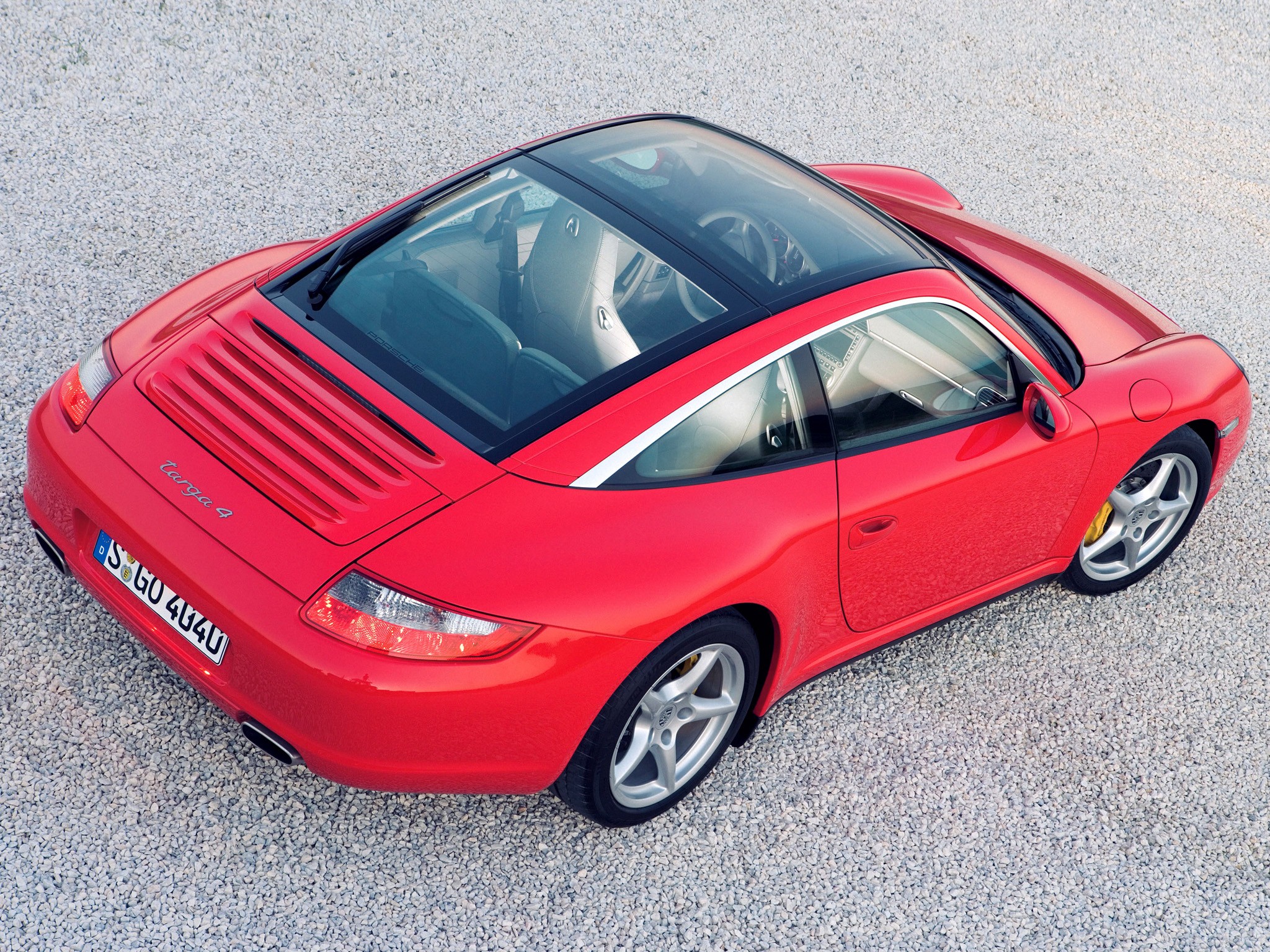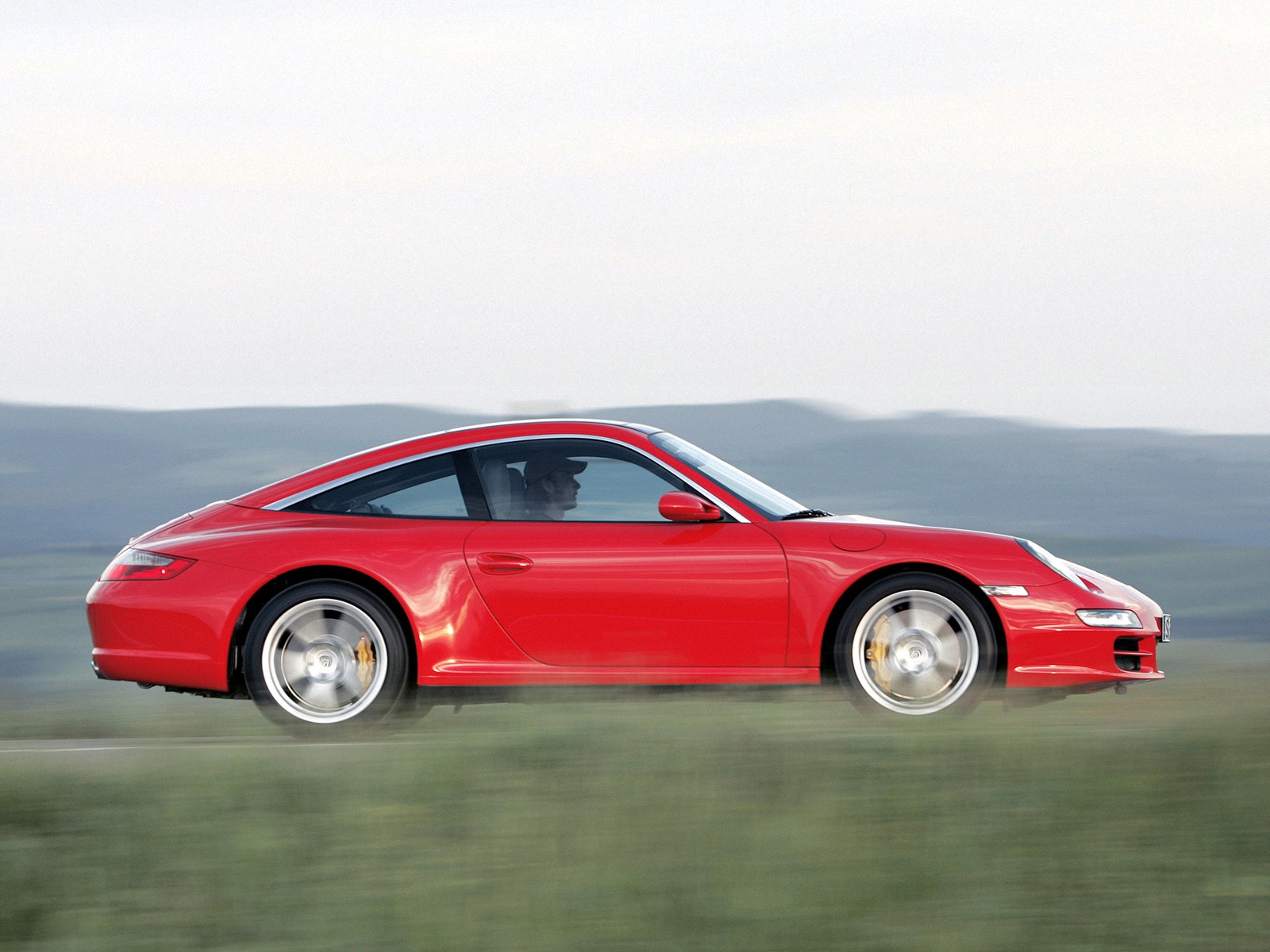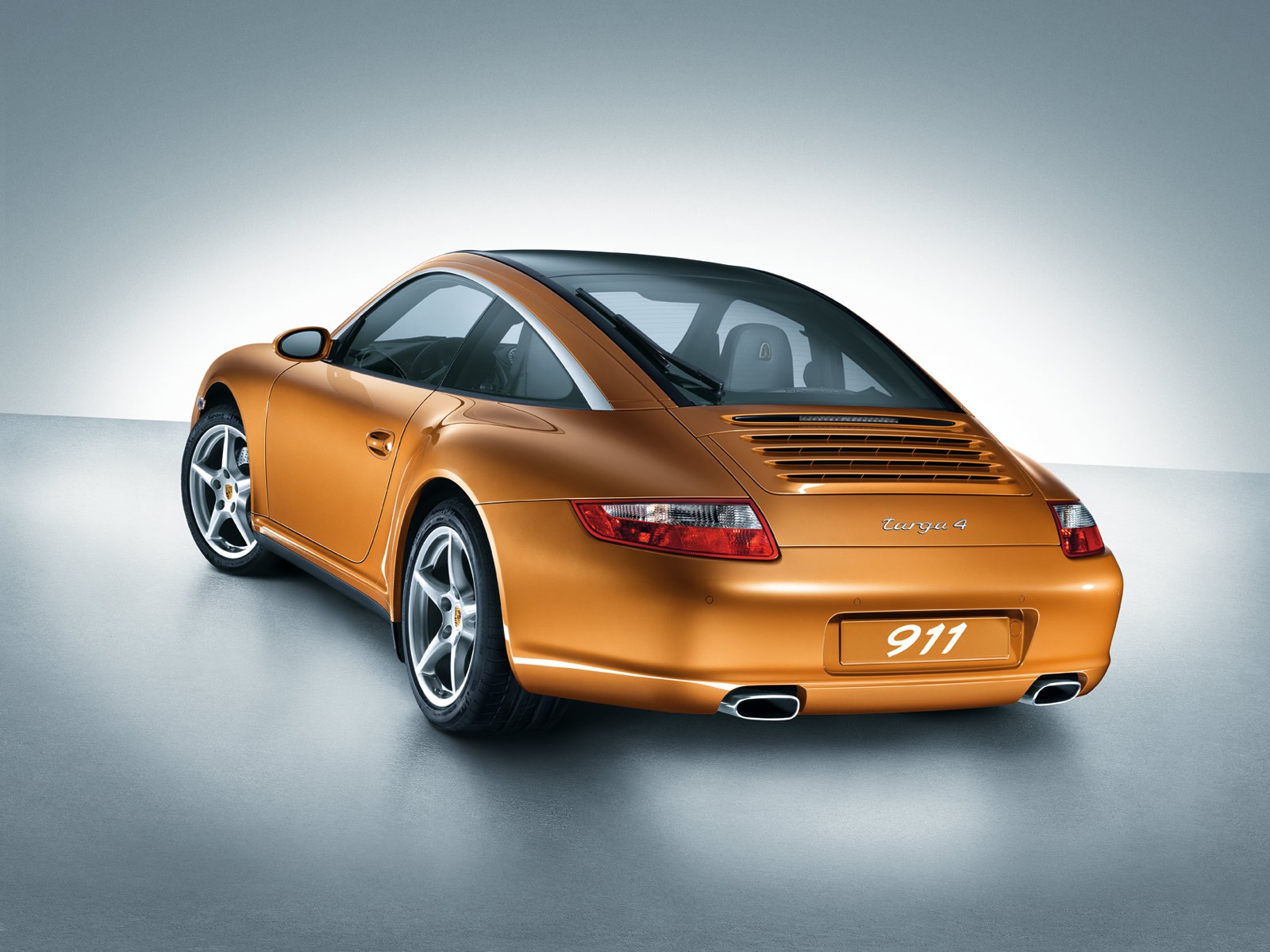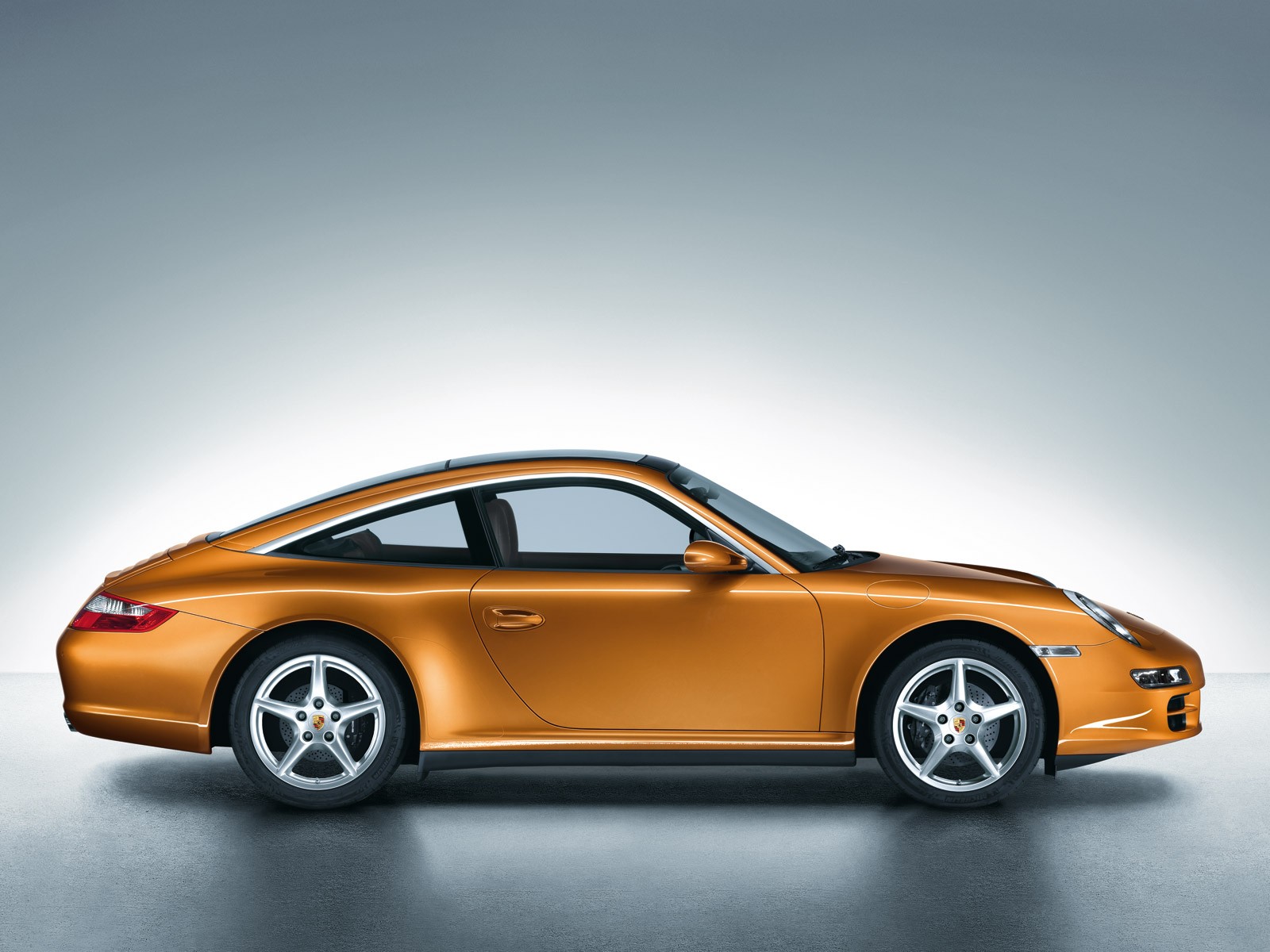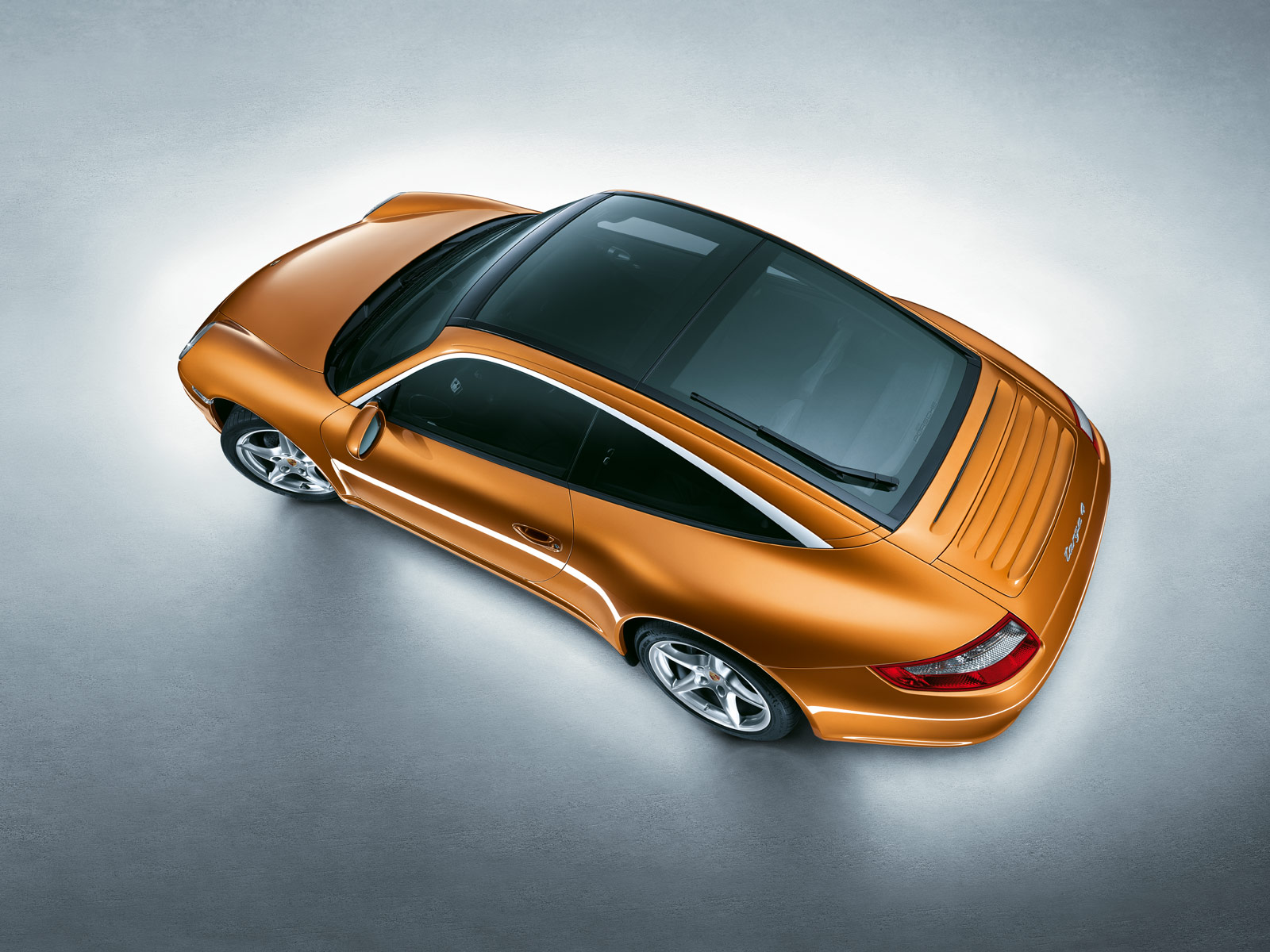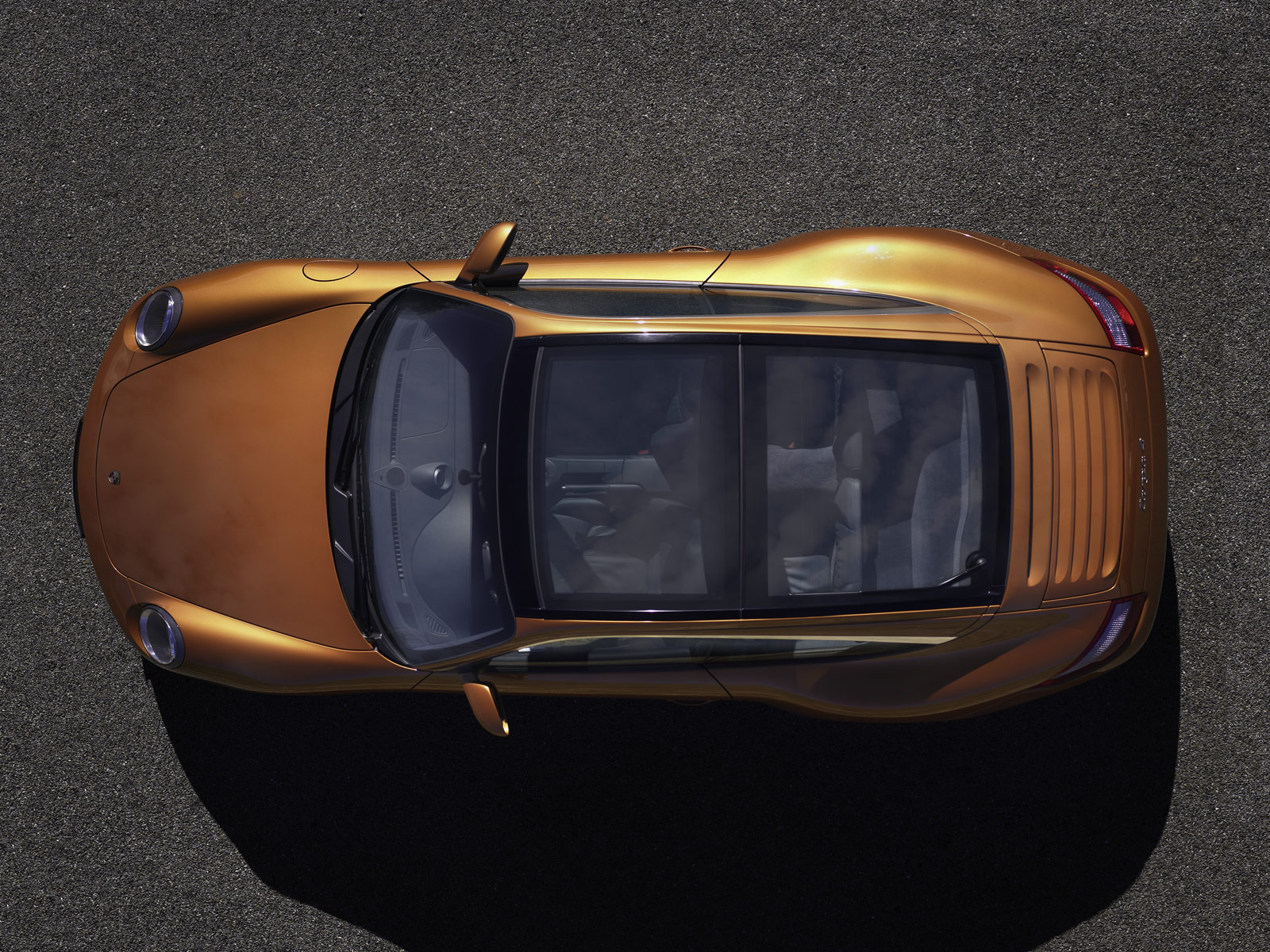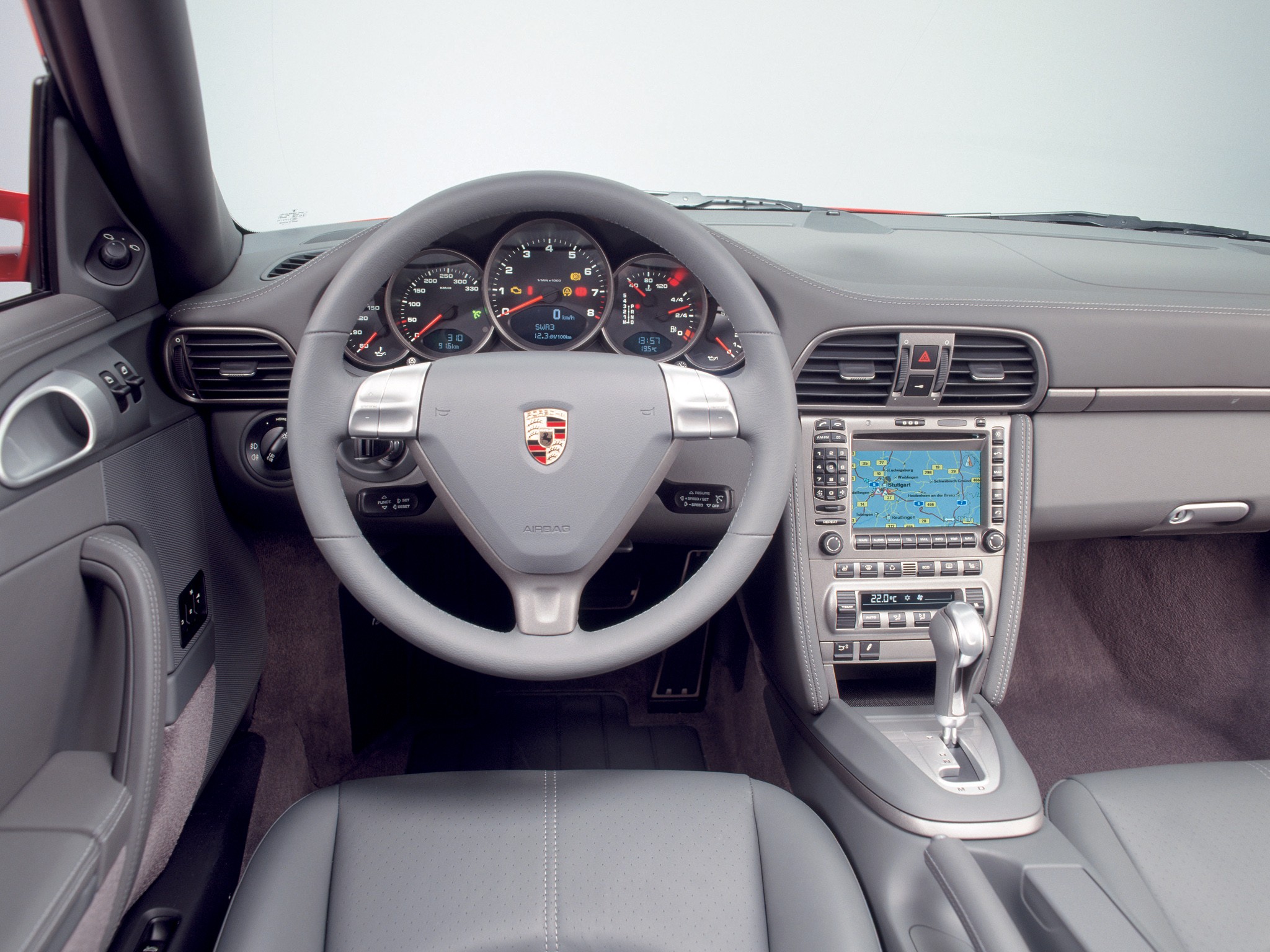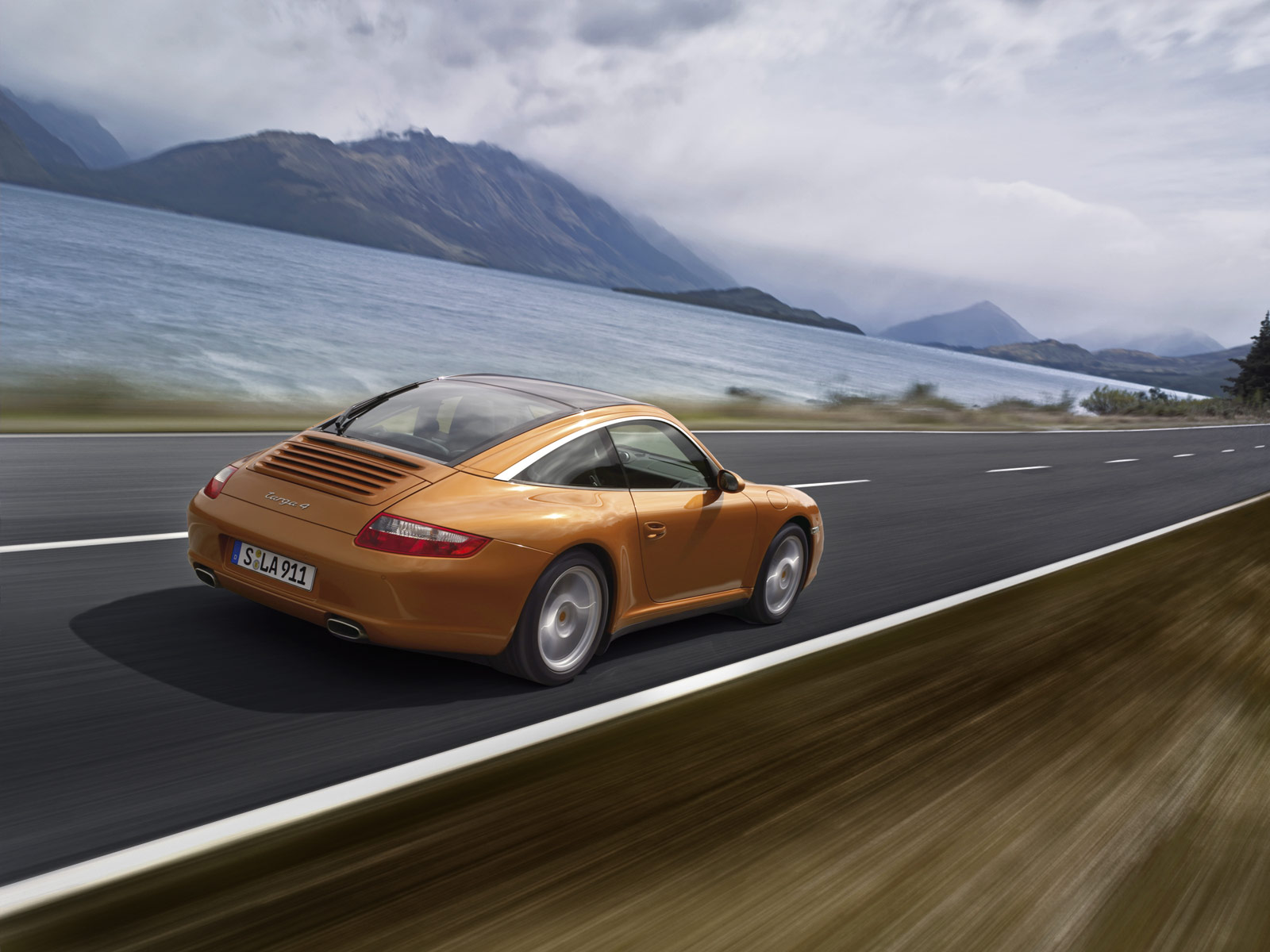(2007 – 2008) Porsche 911 Targa 4 (997) – Ultimate Guide
The hatchback Targa design was only around for the 996 and 997 generation 911 but in that time it won over fans for its practical design and good looks. The 996 and 997 Targa design took the power-operated panoramic sunroof of the prior 993-series 911 Targa and improved on it by way of its lifting rear window glass. The feature stuck around for the 997-based 2007 911 Targa, although the entire operation benefitted from thinner glass that cut approximately 4.2 pounds from its weight relative to the prior 996-series Targa.
The 997 Targa is the perfect 911 for somebody who wants to enjoy open top driving with the added security of a coupe structure, while also getting the benefit of an all-wheel drive system that keeps you safer in wet conditions. Like the 996 and 993 Targa, the 997 Targa continued with a sliding glass roof that motors back behind the driver’s head and convincingly transforms a closed but airy driving experience into a sheltered, semi-open one.
The 997 Targa 4 has softer spring rates than the coupe, a more generous helping of leather in the cabin, a better tally of standard equipment, more storage space behind the front seats and a glass panel that opens like a hatchback above that rear storage are, and allows you to load things into the space behind the front seats from the kerb, rather than through the driver’s door. It is able to store 335 liters of cargo which is more practical than you would expect from a 911. The interior was offered with a choice of two steering wheels and four types of seats. The PCM (Porsche Communication Management) was fitted as standard, but the DVD-based navigation system was on the options list.
The car featured two glass panels that blocked the ultraviolet radiation but remained transparent. Thus, the heat transfer was smaller than on a regular glass panel. To offer better protection, a power shade was included. The front part of the glass slid opened and offered a true Targa experience. Unlike other 911s, the Targa 4 featured hatch-style access. The rear glass was a tailgate, with hinges mounted over the B-pillars. That allowed it to open and provide access to an additional, 230 liters (8.1 cu-ft) storage area behind the rear seats. The roof was opened and closed in seven seconds.
For the engine, the Targa 4 gets the 3.6-liter engine that offered 321 bhp and 273 ft lbs. It was mated as standard with a 6-speed manual, while a 5-speed Tiptronic is optional. This is good for a 0-60mph time of 5.1 seconds and a top speed of 174mph, both slightly slower than the coupe versions of the car, but the same as the Cabriolet versions. The Targa 4 might therefore be all the 911 you ever want; not the fastest or the most visceral, but certainly the most complete car in a very impressive bunch. A great all-rounder.
Pictures
Press Release
The 2007 Porsche 911 Targa 4 and Porsche 911 Targa 4S feature a unique roof system that provides their occupants with a panoramic view even when the top is closed. The Targa’s roof is made from two glass panels and extends across the full width and length of the passenger compartment, from the windshield header to the leading edge of the engine cover and from side frame to side frame. In other words, the entire roof is glass, and in combination with the windshield and side windows provides a panoramic vantage and protection from the elements.
Both glass panels are made from a specially formulated glass that absorbs nearly all ultraviolet radiation yet remains transparent. The glass also is formulated not to transmit the sun’s heat into the vehicle. The top includes an integrated power shade that can be positioned to provide a screen against bright sunlight or insulation against cold temperatures. In addition, the front portion of that glass roof slides open at the touch of a switch to provide a large opening above the driver and front-seat passenger.
911 Targas are the only 911s with hatch-style access. Meanwhile, the rear section of the Targa top comprises a separately opening hatchback-style access to the car’s four-seat interior and especially to the 8.1 cubic feet (230 liters) of storage area behind the rear seatbacks. Of the various versions of the Porsche 911, the Targa is the only one with a separately opening tailgate.
The Targa roof is further differentiated by a polished aluminum exterior trim strip that extends along the edge of the roofline, up from the base of the A pillar and arching along the edge of the roof side support and back to the base of the C pillar. This bright trim gives the Porsche 911 Targa 4 and Porsche 911 Targa 4S a unique side view among all versions of the Porsche 911.
First Targa to offer choice of engines
Porsche first produced a Targa-style roof for the North American market for the 1967 model year. The unique roof style was created in response to early government safety regulations that threatened the future of the traditional canvas-roofed convertible body style. The introduction of the all-new 2007 Porsche 911 Targa 4 and Porsche 911 Targa 4S marks the first time the Porsche Targa has been available with the customer’s choice between two power sources – the 325-horsepower 3.6-liter horizontally opposed six-cylinder engine in the Porsche 911 Targa 4 and a 355-horsepower 3.8-liter “boxer” six in the Porsche 911 Targa 4S.
The 2007 Porsche 911 Targa 4 accelerates to 60 miles per hour in 5.1 seconds and reaches 100 mph in less than 12 seconds on its way to a top speed of 174 miles per hour. The 2007 Porsche 911 Targa 4S, which comes with Porsche Active Suspension Management technology (optional on the Porsche 911 Targa 4), reaches 60 mph in just 4.7 seconds, hits 100 in 11.1 seconds and has a top speed of 179 mph.
First Targas built on wide-body, all-wheel-drive platform
The introduction of the all-new 2007 Porsche 911 Targa 4 and Porsche 911 Targa 4S also marks the first time that this panoramic roof has been featured on the wide-bodied and all-wheel-drive version of the Porsche 911. Regardless of engine selected, all 2007 Targa models feature all-wheel drive for enhanced driving dynamics. The cars’ larger and flared wheel arches provide room for a widened track and larger wheels and tires that are part of Porsche’s all-wheel-drive powertrain that enhances dynamic capabilities in all conditions, but especially in inclement weather.
Enhanced Porsche Stability Management is standard
The Targas also are equipped with enhanced Porsche Stability Management (PSM) technology featuring advanced braking systems engineered to provide the shortest possible stopping distances, a dynamic category in which all Porsche vehicles are among the best in the world. Torque split to the front wheels automatically adjusts between 5 and 40 percent to maintain superior traction. By sending no more than 40 percent of power to the front wheels, the four-wheel-drive 911s exhibit dynamic characteristics similar to the rear-drive versions, thus they will not understeer or “push” toward the outside over the front wheels in turning maneuvers.
Six airbags and a long list of standard features and options
Further, all 2007 Targas are equipped with six airbags – front, side (thorax) and two-row head-protecting side curtains – as standard equipment. In terms of equipment and ergonomics, both versions of the Targa are nearly identical to the 2007 Porsche 911 Carrera 4 and Carrera 4S. Standard equipment includes automatic air conditioning, Porsche Communication Management (PCM) with MP3 capabilities and nine speakers. Also available are a wide range of options for customization, including BOSE Surround Sound, Porsche ParkAssist, Porsche Active Suspension Management (standard on the Porsche 911 Targa 4S), Porsche Ceramic Composite Brakes and Porsche’s Sports Chrono Package Plus, which among others adjusts suspension, engine and Tiptronic S parameters for more enhanced dynamic driving. Owners also have a wide range of leather upholstery, wood and carbon trim options.
Reduced cost of ownership
New technologies and advances in lubricants extend service intervals and should contribute to a lower cost of ownership during the lifespan of the 2007 Porsche 911 Targa 4 and Porsche 911 Targa 4S. Oil changes are required only every 20,000 miles, air filters last until 40,000 miles and spark plugs should be changed at 60,000 miles.
Pricing for the 2007 Porsche 911 Targa 4 is $85,700 (or $119,100 Canadian) while the 2007 Porsche 911 Targa 4S starts at $95,900 (or $133,200 Canadian).
High- and even higher-performance engines
Both of the available engines – a 325-hp, 3.6-liter and a 355-hp, 3.8-liter showcase Porsche’s high standard of technology and combine superior performance with equally superior economy, reliability, and environmental concern. Features include four-valve technology, the two-stage resonance intake manifold, cylinder-specific antiknock control, single ignition coils with solid-state, high-voltage distribution and double oxygen sensor control – in all, a package of special features ensuring the charge cycle and combustion process.
The key element is Porsche’s VarioCam® Plus valve management system that comprises camshaft control on the intake side and valve lift adjustment. This valve lift adjustment system consists of two, cam-operated interacting and switchable cup tappets on the intake side of the engine. The big advantages of VarioCam Plus are more power and torque on one hand as well as greater fuel economy, enhanced emission management and improved refinement on the other.
Beyond boring – the 3.8-liter engine
To create the 3.8-liter engine for the Targa 4S, Porsche engineers did more than simply increase the bore diameter — by 0.12 inches (3 mm). They changed the intake manifold and modified the intake camshaft lift pattern. Injector angles were changed to enhance fuel flow to the center of the combustion chamber. The exhaust manifold also is shorter. The larger engine also gets a higher performance cooling pump and an oil/water heat exchanger with two additional cooling layers. Yet amazingly, the 3.8-liter engine weighs no more than the 3.6-liter unit, thanks to its lighter intake manifold.
Racetrack technology optimizes oil flow
To provide optimum oil flow through both engine blocks and their cylinder heads, Porsche uses integrated dry sump lubrication. Just as on a racecar, this system insures efficient oil distribution even in high-speed cornering. Each engine uses three oil pumps — one in the crankcase and one in each cylinder head, thus assuring proper lubrication despite the forces of hard acceleration, braking or cornering. Further, the oil pump on the 4-5-6 cylinder head is combined with a pneumatic vane-cell pump to provide necessary vacuum for the brake servo as well as the engine and transmission control systems. Most automobile engines simply draw pressure from the intake manifold, but the Porsche system increases efficiency, especially in spirited driving situations.
Powerful, but also clean and efficient
This technology also greatly reduces hydrocarbon emissions following a cold start and engine warm-up. Because engine oil level is monitored electronically every time the car starts, the engine has no need for the traditional dipstick. This is yet another example of Porsche engineers’ dedication to reducing unnecessary components and to reducing overall vehicle weight.
Considering their superior engine output and high speed capabilities, both models can be regarded as very fuelefficient: The flat-six in the Porsche 911 Targa 4 consumes just 18 miles per gallon in city cycle driving and 26 at routine highway speeds. The 2007 Porsche 911 Targa 4 and Targa 4S also meet Low Emission Vehicle (LEV II) standards.
Six-speed manual or five-speed automatic
All models in the 911 range come as standard with a smooth and precisely shifting six-speed manual gearbox. For the purposes of all-wheel drive, the gearbox features an additional output drive shaft leading to the front axle drive. Five-speed Tiptronic® S is available as an alternative and features electronic transmission management with a range of gearshift strategies extending from comfortable cruising all the way to an extremely sporting style of motoring. In the process, the gearshift points adjust infinitely to the driver’s personal style and route profile. The driver can shift gears manually on the automatic transmission simply by moving the selector lever from the automatic position and using rocker switches in the spokes of the steering wheel. Responding instantaneously to the driver’s commands, the transmission ensures a smooth flow of power with hardly any interruption.
The driver may even use the gearshift paddles in the automatic mode, for example, to shift down spontaneously when passing or use the braking power of the engine when steering into a bend.
To mimic the way an enthusiast driver manipulates the accelerator, brake and clutch, engine management software produces a slight boost in engine speed during aggressive downshifting. This shortens shift time and enhances gearshift mesh. With the Tiptronic S selector lever is in its manual mode and the PSM OFF switch activated, the transmission will not shift up even when the engine reaches the rev limiter. This allows the enthusiast driver to drive with the engine near its rev limit while maintaining the selected gear.
Refined and sporting suspension
Both the Porsche 911 Targa 4 and Porsche 911 Targa 4S come with a suspension set-up combining superior comfort with equally superior sportiness. Porsche Active Suspension Management (PASM), optionally available on the Porsche 911 Targa 4 and standard on the Porsche 911 Targa 4S, offers a sporting but comfortable damper set-up in the Normal mode and switches over to a dynamic and firm set-up once the driver presses the Sports button. In either position, the suspension adjusts consistently to the driver’s style of motoring and road conditions, thus varying its control and operation maps within fractions of a second.
The Porsche 911 Targa 4 comes with 8 x 18-inch wheels wrapped by 235/40 ZR tires in front and 295/35 ZR tires at the rear. The Porsche 911 Targa 4S features 8 x 19 wheels with 235/35 ZR tires in front and 305/30 ZR tires at the rear. This asymetric tire setup is optimized by Porsche’s four-wheel-drive system to assure outstanding grip and dynamic control.
Outstanding brakes
The Porsche 911 Targa 4 features black eloxy-plated aluminium monobloc fixed-calliper brakes with four pistons each on all four wheels, acting on the cross-drilled, inner-vented brake discs. Disc diameter is 12.52 inches (318 mm) on the front wheels and 11.77 inches (299 mm) at the rear.
The S model features even more powerful brakes reflecting the car’s even better performance: The Porsche 911 Targa 4S comes with larger and reinforced four-piston monobloc fixed callipers finished in red. The inner-vented and cross-drilled brake discs are also larger in size, measuring 13.00 inches (330 mm) in diameter both front and rear. This also allows the use of larger brake pads increasing the overall swept area covered by the brakes and the overall service life of the brake system.
Featuring a tandem brake servo, an extra-large master brake cylinder and Porsche Stability Management enhanced to an even higher standard, the other brake components are tailored to the dynamic performance of this all-wheel-drive sports car. To eliminate the air gap between the brake pads and the brake disc, for example, the brake system is pre-loaded prior to emergency application of the brakes, thus ensuring even shorter stopping distances when braking all-out. And should the driver press down the brake pedal quickly, but not with sufficient force, the hydraulic pump will set off any lack of pressure to activate ABS on all wheels and thus guarantee optimum brake performance.
Porsche Ceramic Composite Brakes are available
As an option, both cars are available with Porsche Ceramic Composite Brakes (PCCB®) that feature composite ceramic discs that are approximately 50 per cent lighter than comparable brake discs made of grey-cast iron. The advantage is quick, substantial and consistent deceleration while reducing abrasion to a minimum.
Sports Chrono Package Plus enhances dynamic capabilities
Like the other models in the 911 range, the Targa 4 and 4S can be equipped with Porsche’s Sports Chrono Package Plus. Designed for the particularly sporting driver, the system is most readily identified by the clockstyle gauge mounted on top of the dashboard. When engaged, the system opens more aggressive electronic control maps for the Motronic engine management system as well as for Porsche Stability Management (PSM), Porsche Active Suspension Management (PASM) and for the Tiptronic S transmission (on vehicles equipped with these options). The revised Motronic maps strongly favor performance over comfort and provide even quicker engine response, not only on deployment but also on release of the throttle. Even the Tiptronic S transmission makes its shifts more aggressively. Further, PSM thresholds, including ABS settings, allow more lateral slip before intervention and PASM switches to its firmer setting to provide more agility in cornering.
However, in some instances, such as on wet pavement, a softer suspension setting can be advantageous so the driver using Sport Chrono can easily press the PASM button to return to the Normal damper settings. The Sport Chrono package includes a digital/analog stopwatch that not only records lap times that can be displayed on the Porsche Communication Management (PCM) screen for review.
Porsche Communications Management is standard equipment
Porsche Communication Management (PCM) is included as standard equipment in both the 2007 Porsche 911 Targa and Targa 4S models. The PCM system controls many functions including audio and the (optional) navigation system. An optional DVD-based navigation system located in the luggage compartment and allows the slot in the system in the center console to be used for playing audio CDs. The system also is MP3 compatible. In addition, PCM offers an optional electronic logbook that allows automatic recording of mileage, journey length, date and time as well as the starting point and destination address for every trip made. An optional extended navigation module includes “back-trace” technology so you can find your way back to your starting point even when the roads you travel may not appear on the navigation system map.
Also standard on PCM is a Sound Package Plus, which includes nine speakers with three times the usual transmission area and with an external analog amplifier for outstanding sound in all driving conditions. A six-disc CD changer is available as an option.
Optional Bose® Surround Sound System
The Porsche 911 Targa 4 and Porsche 911 Targa 4S Coupes are available with a Bose Surround Sound System with 13 speakers and a seven-channel digital amplifier integrated into the MOST bus ensuring outstanding sound quality. The heart of the Bose Surround Sound System is a digital amplifier with a 5 x 25 watt output and additional support from integrated and external 100-watt switching terminals. Active electronic equalization adjusts the reproduction of sound to specific acoustic conditions so all passengers enjoy a sound experience. The system includes Bose’s AudioPilot technology that automatically adjusts frequency levels to compensate for wind or road noise inside the vehicle. A special microphone in the steering column cover picks up such noises.
A choice of steering wheels
The standard steering wheel in the Porsche 911 Targa 4 and Porsche 911 Targa 4S has a dynamic three-spoke design and is adjustable both in height and reach. In keeping with the engineering theme of lightweight technology, the wheel is supported by a composite magnesium structure that reduces the weight of the steering wheel assembly. A multifunction steering wheel is available. This wheel allows the driver to operate audio, navigation and telephone equipment via controls mounted on the steering wheel. In addition to the standard leather colors that match the rest of the interior, the multifunction steering wheel is available with wood grain, aluminum or carbon trim on its outer ring.
Four seating options
Driver and passenger seats in the Porsche 911 Targa 4 and Porsche 911 Targa 4S feature a Porsche-patented system engineered to better absorb vibration on long trips. Of course, they also provide outstanding lateral support to keep the driver and passenger in place when experiencing high lateral acceleration through curves. The seats also are designed to accommodate taller drivers and passengers. Pedals are positioned closer to the firewall to better accommodate drivers with long legs. The seats are mounted close to the floor pan to help keep the center of gravity as low as possible. This positioning also created more headroom for taller occupants. Lightweight technology is used in the seat structure. The standard front seats are adjustable in six directions — fore and aft, height and backrest angle. Height adjustment is made through a mechanical step function positioned between the seat and the doorsill. Backrest angle is electrically controlled.
All-electric seats are available and adjustable in 12 directions, including the angle of the seat cushion and through lumbar support comprising four air chambers. These seats also have a memory feature. Sport seats with even greater lateral support, both in the seat cushion and shoulder area, are available. These seats also have firmer padding. Adaptive sport seats provide a fourth option. They combine the sports design with electrical controls. These seats have four-dimensional adjustment that includes adjusting the width to fit the occupant.
Standard anti-theft warning system
The 2007 Porsche 911 Targa 4 and 911 Targa 4S feature a standard anti-theft warning system that uses radar to maintain surveillance of the vehicle interior. Unlike some systems, this sensor is not affected by reflections from bright interior leather surfaces. Also standard is a programmable HomeLink® system that can open a garage door or turn on the lights in your home.
Safe by design
The inner roof structure in the Porsche 911 Targa 4 and Porsche 911 Targa 4S ensures superior safety and stability at all times. As on the 911 Carrera Cabriolet, 1.18-inch (30 mm) thick tubes made of ultra-strong steel reinforce the A-pillars. Welded directly on to additional tubes extending along the edge of the roof and resting on the body of the car via the B-pillars and at the bottom of the C-pillars, these special tubes ensure very good protection of the occupants even in a rollover. Due to the use of high- and ultra-high-strength steel as well as improvements in spot-welding and bonding, the Targa bodies are extremely torsionally rigid and flex resistance while still being lightweight. Like all Porsche sports cars, the Targa comes as standard inside with Porsche’s comprehensive airbag system featuring a total of no less than six airbags for maximum safety.
It’s quiet – and dry – inside
Special spring mounts for the roof module ensure excellent soundproofing and dampen sound transmission with the roof open or closed. To achieve this effect, plate springs disconnect the glass roof mounting points and take up vibrations at the side. Since the upper glass segment is moved via cables driven by two electric motors at the rear of the car, vibrations are not conveyed.
The roof itself opens or closes within seven seconds. When opened, the front roof cover glides beneath the glass tailgate, with the tailgate always remaining closed when opening the roof for safety reasons. Conversely, the roof has to be closed whenever the driver wishes to open the tailgate. In developing the roof and the mechanical operating system, Porsche engineers focused not only on straightforward, smooth and unproblematic operation, but on an improved sealing system to minimize wind noise also at high speeds.
A so-called underpinning sealing system keeps out water and moisture in three ways: The first barrier is formed by a rubber lip across the windshield frame. The second countermeasure is a small gutter at the rear of the sliding roof; even if the roof is wet when opened, water is chaneled by the gutter to aluminium guide rails. This feature interacts with the main hose-profile seal on the edges of the glass sliding roof.
Yet a further seal is fitted on the aluminium frame. With aerodynamically induced pressure on the outer roof contour increasing as a function of speed, the glass sliding roof is then pressed harder into the underpinning seal.
Complete glass module with its own frame
A self-bearing modular frame made of steel plate and featuring riveted aluminium guide profiles accommodating the glass sliding roof and its guide rails, operating motor, wind deflector, roll cover and the folding tailgate forms the backbone of the glass roof module. A crossbar between the sliding roof and the tailgate accommodates the centre joint and tailgate seals and holds the sliding roof seal in position. The entire roof module is fastened in position by 16 bolts at the bottom on the roof supports, the windscreen frame and rear crossbar. The connection seams leading to the body of the car are covered at the outside by black-colored plexiglas trim with rubber lips overlapping the glass elements. Inside, high-quality, sophisticated cover elements of plastic and aluminium ensure an absolutely smooth and even transition.
Targa history
The 2007 Porsche 911 Targa 4 and 911 Targa 4S represent the third generation of the Porsche Targa equipped with a glass roof. The Targa brand comes from the famous Targa Florio road race and was patented by Porsche in the mid-1060s for the new open-air driving concept the company introduced at the time. In September, 1965 Porsche presented the 911 Targa as the world’s first so-called Safety Cabriolet at the Frankfurt Motor Show. With a rollbar fitted in position, the removable folding roof catered to American customers and their greater demand for safety. Production started in 1966 and the “semi-open” 911 Targa was introduced into the market in 1967. This roof concept was further developed over a period of 27 years. During these years, this special version of the 911 quickly gained the status of a unique concept within Porsche’s model range and was chosen on average by one out of every ten purchasers of a 911.
In 1996, a new version of the Porsche 911 Targa was presented. Now the entire roof was one large glass panel, with the glass sliding section at the front moving down and beneath the glass window at the rear. Toward the end of 2001, Porsche introduced a new Targa based on the next generation of the 911. Now, the latest Porsche 911 Targa 4 and Porsche 911 Targa 4S take up this design concept and configuration and add new advantages and features.


